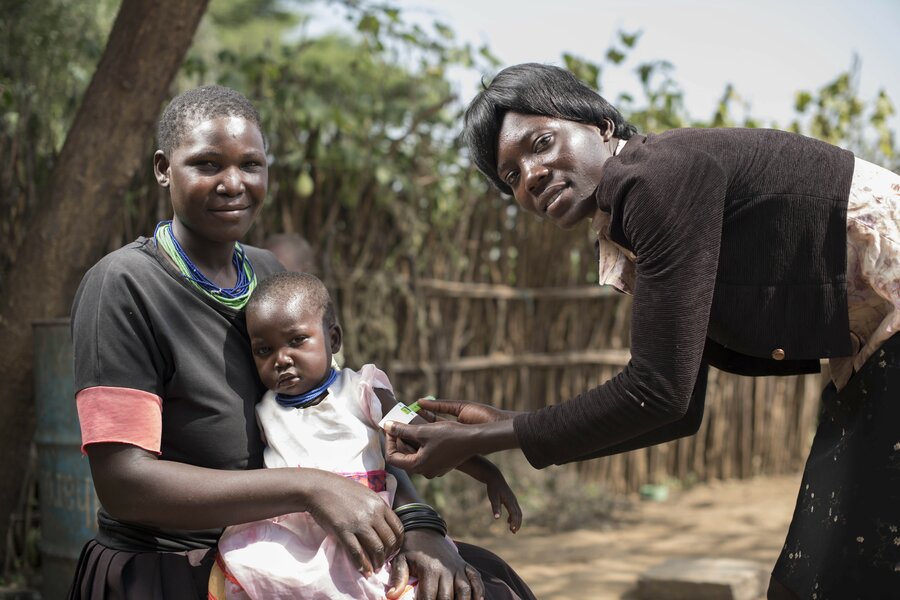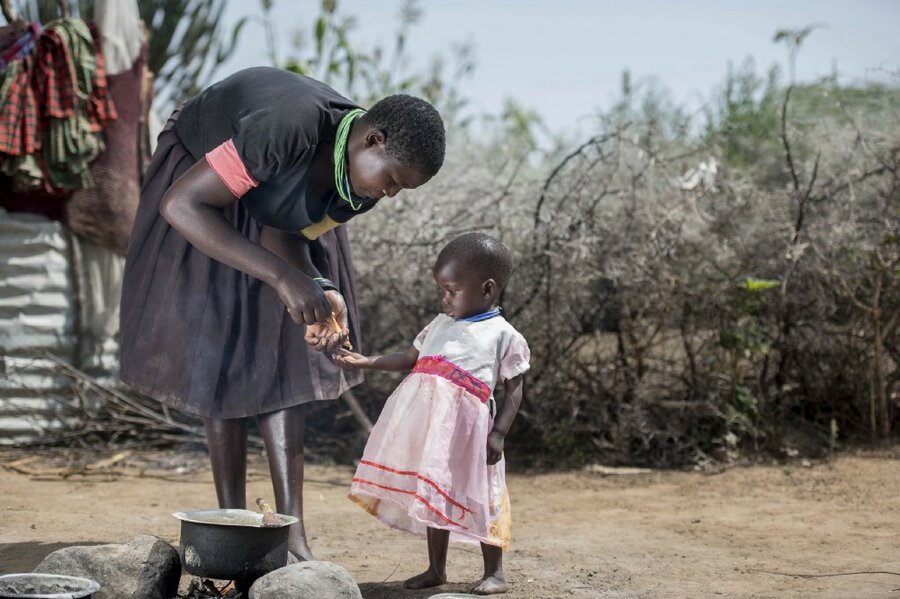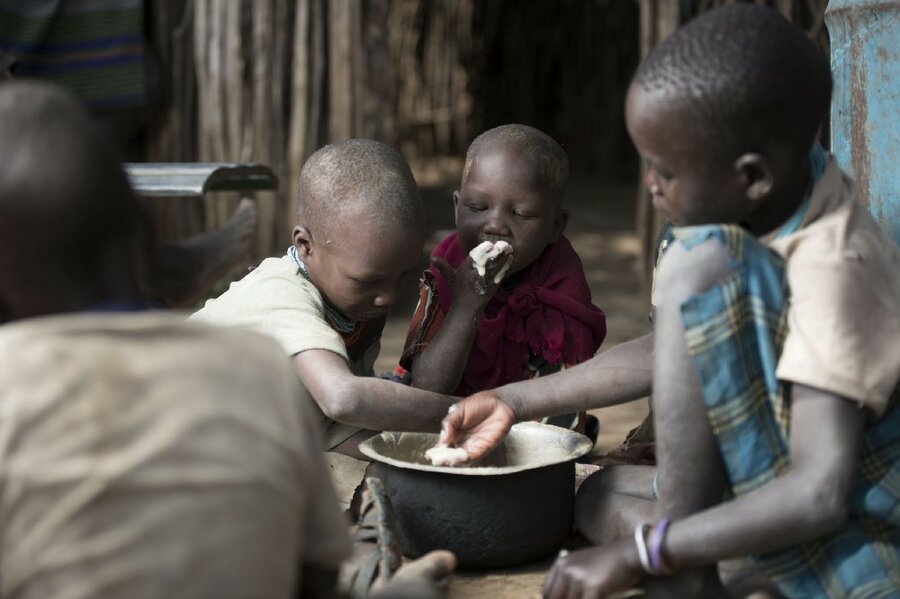New approach to addressing malnutrition in Uganda shows promise in saving more children’s lives
Faced with the stubborn challenge of reducing child malnutrition in Uganda's poorest region, the World Food Programme (WFP), UNICEF and the Ugandan government came up with a new mechanism to help more children survive and thrive.

Susan Liko had to walk 40 kilometres through the northeastern Karamoja region of Uganda earlier this year — from her home to a hospital — carrying her 26-month-old daughter, Alyat Nakiru, who was losing weight because of tuberculosis.
"I had neither money nor food for the journey," Susan remembers. "All I had on me was a jug of water and a shawl covering my child. I was frustrated because she would not breastfeed."
Susan's husband was not at home when she left on the two-day journey. Alyat was treated at Matany Hospital for a month, meaning Susan had to stay with her, leaving her four other children aged 12 to 5 at their home in Loputuk parish.
Health workers said that Alyat was acutely malnourished and she should be enrolled in community-based supplementary feeding at home in Loputuk.
This Government programme is one of three ways in which WFP provides food to vulnerable people in Karamoja, a region historically known for severe droughts, chronic food shortages and high rates of all forms of malnutrition.
The other programmes include school meals and a mother-and-child health project to protect children against stunting and underweight.
WFP began supporting the localized programmes years ago, primarily to help reduce the distances that mothers in need of life-saving assistance for malnutrition must walk with their sick children to reach health centres.
WFP engages village health teams, screening children house-to-house and referring the moderately malnourished ones to the community-based programme, where mothers receive WFP's specialized nutritious food.
Severely malnourished children are referred to Government health centres, where UNICEF manages their condition. WFP also works with non-governmental organizations and government health workers providing nutrition education and health services to combat malnutrition.

Partners draw up a new strategy
In December 2017, the partners, with financial support from the United Kingdom, came up with a new approach: emphasizing increased investment to prevent malnutrition, especially by addressing sanitation, hygiene, child care and feeding practices, and by strengthening government health systems.
The new strategy brings together nutrition, education, health and agricultural production partners to tackle malnutrition in Karamoja through increased coordination among district leaders. WFP and UNICEF continue to treat malnutrition.
Nutrition data is now digitized. The data that is generated helps to better inform the actions of partners. Active engagement of local politicians and adult literacy experts to drive changes in social behaviour at home is another focus area.
"Malnutrition is closely associated with child illness, which is why children are immunized, dewormed and treated for diseases before receiving food," says Timothy Chewere, a nutritionist with Andre Foods International, WFP's NGO partner.
"However, for years it has been challenging to accurately determine the nutrition status of children and women especially using weigh-for-height… This sometimes led to inaccurate diagnoses and wrong referrals, which resulted in high non-response rates," he says.
WFP's transformative technology
But now, WFP innovative technology, known as SCOPE CODA "simplifies the assessment of malnutrition, and, most importantly, indicates the right kind of treatment for each malnourished child or mother," says Chewere. "Moreover, the application helps to prevent mothers from skipping clinic visits, which also previously contributed to non-response and extended stays on the programme," he adds.
SCOPE CODA is an application that builds on SCOPE, WFP's digital beneficiary management system, designed to meet the technical needs of nutrition treatment by providing one digital platform to register children and monitor performance.
WFP increased its support to more community-based centres this year, integrating more community leaders in the system. They have been able to pass on behavioural change messages with training sponsored by UNICEF.

Alyat is now happy and feeds well
Chewere is speaking at Alyat's home, two months after she was discharged from the WFP programme. The family shares a compound with the village chairperson, Raphael Loupe, who is also one of the UNICEF trainees.
Alyat rests on her mother's chest. She wears a clean chiffon dress with a big red band on the waist and two smaller ones at the bottom. Susan's hair is wet, a sign that she probably just had a wash. The family's compound looks clean.
Susan has built a bath shelter and a plate stand, and keeps a jerrycan of clean water — in line with Raphael's advice that these items, along with water, are important to boosting sanitation and hygiene, and drinking water more regularly.
"Alyat is now a happy child with an appetite," says Susan. "She has not suffered any serious illness since she was discharged."
Susan is gathering tinder to cook mid-morning porridge for her children. In the past, the family typically cooked one meal each day in the evening. Now the children eat more often in line with Raphael's advice — if food is available.
In July 2016 and July 2017, the supplementary feeding programme at the Loputuk outpost clinic admitted more than 300 children a day on average, of which more than 30 percent failed to respond to treatment. In 2018, WFP admitted some 100 patients a day, of which less than 15 percent failed to respond to treatment. Almost none of the participating mothers dropped out of the programme — a new precedent.
"If you listen to the community leaders and do what they say," Susan says, "you find that your child gets well."
WFP is extremely grateful to Canada, the People's Republic of China, the United Kingdom, Irish Aid (through UNDP) and multilateral donors for their contributions to the nutrition programmes in Karamoja.
